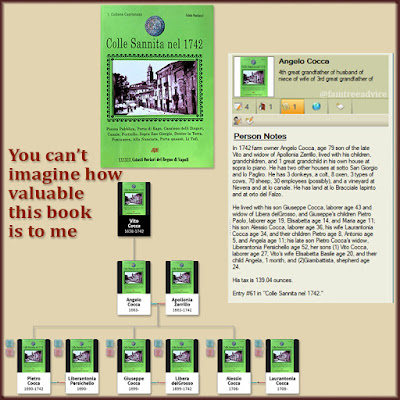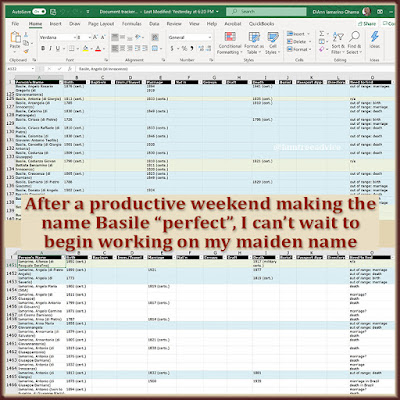How ironic. Last time, I encouraged you to slow down and be more thorough in your family tree building. I'm having terrific results practicing what I preached. I've been checking every person in my tree with my maiden name. I'm gathering their missing documents. I'm fixing their sources. I'm updating my document tracker. It's awesome.
Then I thought I'd better have a quick look for new DNA matches. Next thing you know, I get swept into a marathon session of finding their ancestors, and working them into my tree.
By the time I came up for air, I'd added basic facts for about 30 people to my tree. Without any sources! Most of the people will be easy to fix. I entered their birth or marriage dates, so I can get their documents cropped and placed in my tree. The documents will help me make strong source citations.
Some of the names and facts rely on my DNA match's tree. I have no documentary proof yet. For them, I'll make a note in my tree and point to my DNA match's family tree online.
I finally stopped this feverish family building when I realized I had no idea how many people I'd added to my tree. How would I retrace my steps when I'd been jumping around among a few DNA matches?
Luckily, I recently learned something new about Family Tree Maker. Maybe this feature has always been there—hiding in plain sight. When you open your tree file in FTM and you're on the Plan tab, there's a place to create a task list. What I never noticed is that there's another tab next to Tasks called Change Log.
 |
| Does your genealogy program have this safety net? |
The Change Log lists up to 1,000 of the most recent changes you made to your tree, and it timestamps each action. Right now I can see each action for the past 4 busy days. That's fine—I only need to see what I did today.
I printed the change log to a PDF. Now I can accurately and fully retrace my steps. I'll give each person their birth, marriage, and death records. I'll add a detailed note for facts that came from my DNA match's tree.
Almost a year ago, I made it a habit to save the "Sync Change Log" each time I synchronize my FTM tree to Ancestry.com. Much like the Change Log, this PDF details everything I did since my last sync.
Those files will save the day if something goes wrong with your synchronization or your file. The Sync Change Log is an option you'll see shortly after you begin the sync process. See "Log" below.
 |
| Make family tree safety a top priority. Start with an external hard drive. |
Speaking of family tree safety, I make a full backup of my family tree file during and after each session. The backup files are very big because my tree is so large. I move them to an external hard drive each week during my Sunday computer backup routine. The sync log files are very small.
My safety routine is this:
- Backup: Make a full backup of the family tree, media files included.
- Compact: Close the family tree file, but not the software program. Compact the file (see the Tools menu), being sure to check "Perform extended analysis". Repeat, if needed, until the compact process reduces the file size by 0%.
- Sync: Open the family tree again and click Sync Now.
- Log: The Sync Change Log window shows you how many people, media, and citations you've changed. Click the View / Print Details button. This opens a file showing your changes since the last sync. Choose to Export As PDF, close the window, and continue the sync.
- Close: Give your tree a few moments after the sync is complete to process any media files. Then close the file before exiting the program.
- Backup: Make it a routine to back up all your family tree files to a safe location, like an external hard drive or two.
That's about as safe as you can be. After an unexplained sync crash last November, I made sure to be as careful with my family tree as I possibly can. Are you safeguarding your hard work?








